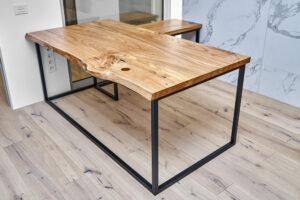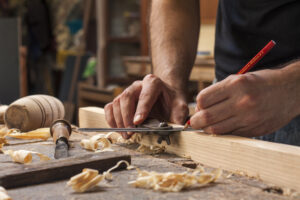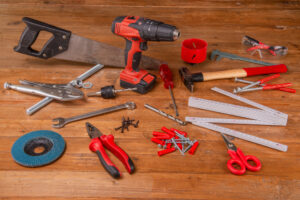
Understanding wood joinery is essential for improving your woodworking skills. There are various types of wood joints, each serving a different purpose and offering different levels of strength and complexity. These joints are used in a wide range of woodworking projects to provide structural integrity and aesthetic appeal.
Key Takeaways
- Wood joinery is crucial for woodworking projects.
- Different types of wood joints offer varying levels of strength and complexity.
- Common wood joints include the butt joint, mitered butt joint, dowel joint, biscuit joint, dado joint, rabbet joint, mortise-and-tenon joint, finger joint, dovetail joint, half-blind dovetail joint, sliding dovetail, half-lap joint, bridle joint, tongue-and-groove joint, and pocket joint.
- Each wood joint has its specific applications in carpentry.
- Selecting the right wood joint ensures the success of your woodworking project.
Common Types of Wood Joints
When it comes to woodworking, understanding the different types of wood joints is crucial for successful carpentry projects. Each type of joint offers its unique characteristics and applications, allowing craftsmen to create sturdy and visually appealing structures. In this section, I will discuss some of the most common types of wood joints used in carpentry.
1. Butt Joint
The butt joint is the simplest type of wood joint, where the end of one piece of wood is joined to another piece by butting them together. This joint is easy to construct but is generally considered weak without additional reinforcement such as nails or screws. Butt joints are commonly used in basic woodworking projects where strength is less critical.
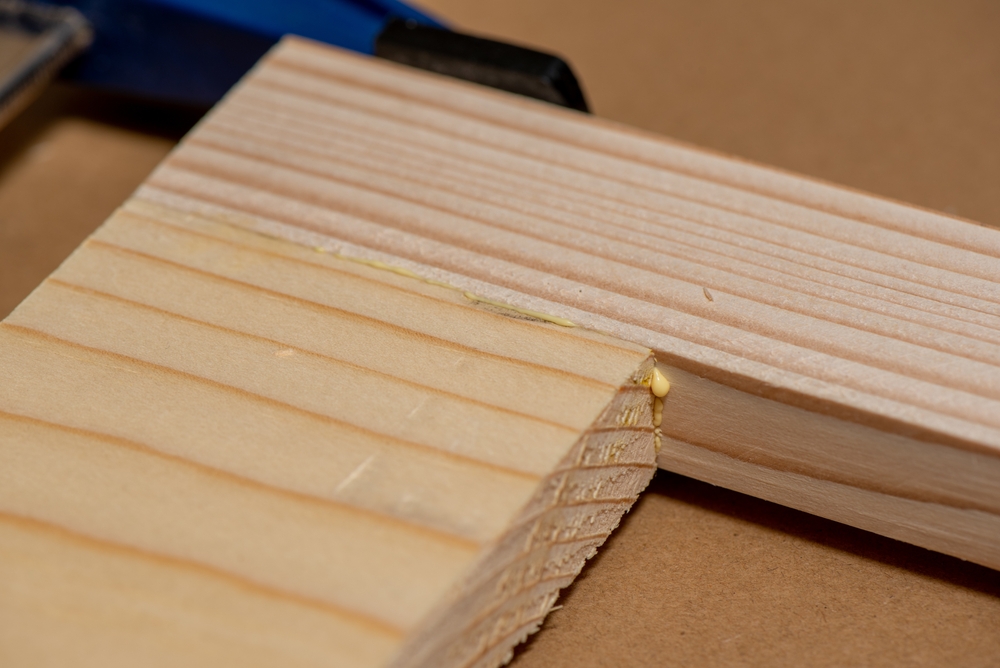
2. Mitered Butt Joint
The mitered butt joint is a variation of the standard butt joint, where two pieces of wood are joined at an angle to form a neat, clean corner. This joint is commonly used in trim work and furniture construction, as it provides a visually pleasing finish by hiding the end grain of the wood.

3. Dowel Joint
The dowel joint involves joining two pieces of wood by inserting dowels (small cylindrical rods) into pre-drilled holes. This type of joint provides added strength and stability, making it suitable for building chairs, tables, and picture frames. Dowel joints are often used for aligning and reinforcing butt joints.
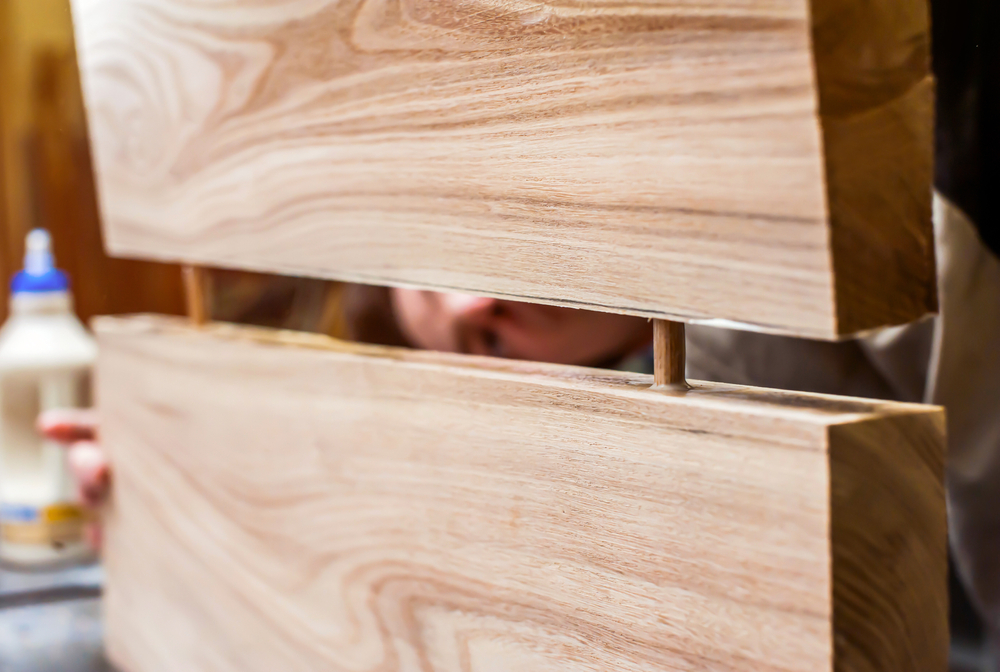
4. Biscuit Joint
A biscuit joint is created by cutting slots into adjoining wood pieces and inserting an oval-shaped wooden biscuit coated in glue. When the glue dries, it forms a strong bond, adding strength and alignment to the joint. Biscuit joints are commonly used in tabletops and cabinetry, as they create a flat and visually appealing connection.
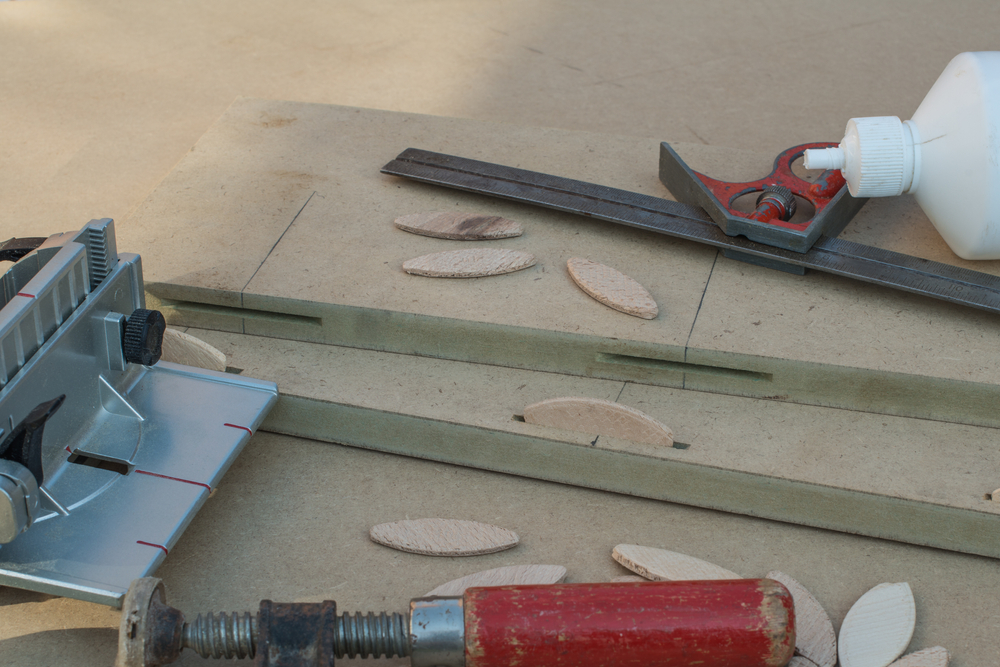
5. Dado Joint
The dado joint involves cutting a channel or groove into one piece of wood to fit another piece, creating a strong connection. This joint is typically used in shelving, cabinetry, and box construction, as it provides structural support and stability.
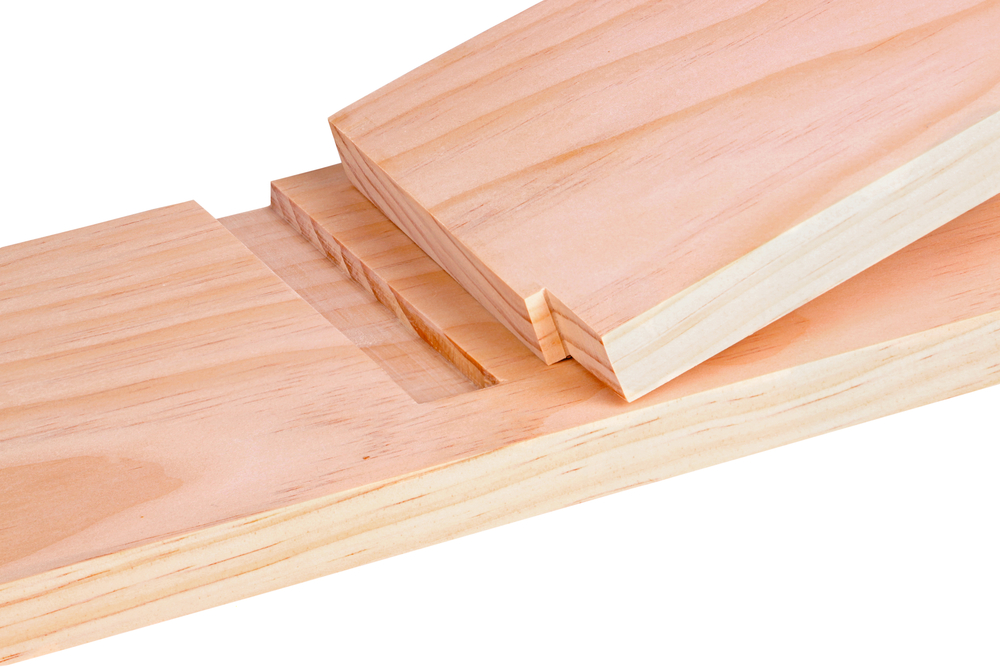
These are just a few examples of the many types of wood joints used in carpentry. Each joint has its own advantages, applications, and levels of complexity, allowing woodworkers to choose the most suitable joint for their specific project. By understanding the characteristics and techniques of each joint, craftsmen can create sturdy and visually appealing structures.
| Joint Type | Advantages | Applications |
|---|---|---|
| Butt Joint | Simple construction | Basic woodworking projects |
| Mitered Butt Joint | Visually appealing finish | Trim work, furniture construction |
| Dowel Joint | Added strength and stability | Chairs, tables, picture frames |
| Biscuit Joint | Strong and flat connection | Tabletops, cabinetry |
| Dado Joint | Structural support and stability | Shelving, cabinetry, box construction |
Butt Joint
The butt joint is one of the most basic types of wood joints used in carpentry. It involves joining the end of one piece of wood directly against the end of another piece, without any shaping or additional support. This simple joint is commonly used in building framing and other applications where additional fasteners such as nails or screws are used for added strength.
While the butt joint is easy to create, it is considered weak on its own due to its limited surface area for adhesion. Without additional support, such as fasteners or reinforcement, the joint may be prone to failure under stress. However, when combined with appropriate construction methods, the butt joint can provide adequate strength for many woodworking projects.
Here are some key points about the butt joint construction:
- Simple and quick to create
- Requires additional fasteners for increased strength
- Used in building framing for structural support
- Commonly reinforced with nails or screws
The image above visually represents a butt joint, showcasing how the end of one piece of wood is joined directly against the end of another piece.
Mitered Butt Joint
A mitered butt joint is a slightly more complex and visually pleasing variation of the basic butt joint. It involves joining angled boards at the ends to form a compound angle. The miters, or angled cuts, create a seamless joint that hides the end grain of both boards. This makes the mitered butt joint particularly popular for trim work and furniture, where visual appeal is important.
When creating a mitered butt joint, precise and accurate measurement and cutting are crucial for achieving a seamless fit. The angle of the miter cut is typically set at 45 degrees, although other angles can be used to suit the specific project requirements.
Advantages of Mitered Butt Joints
- The mitered butt joint provides a clean and seamless joint where the end grain is hidden, resulting in a more polished and professional appearance.
- It is suitable for creating corners on trim work, such as baseboards, crown molding, and picture frames, where the joint needs to blend in seamlessly with the overall design.
- Mitered butt joints are commonly used in furniture assembly, especially for joining pieces at right angles, such as the corners of cabinets, tables, and frames.
Limitations of Mitered Butt Joints
- Mitered butt joints lack mechanical strength and rely heavily on the adhesive used to bond the two angled boards together. Reinforcing the joint with additional fasteners, such as nails or screws, is often necessary to ensure long-term stability.
- The precision required for achieving perfectly aligned and tight-fitting mitered butt joints can be challenging for beginners or those without the appropriate tools, resulting in gaps or misaligned corners.
- Mitered butt joints may be more susceptible to damage if subject to stress or movement, as the joint relies on the strength of the glue and fasteners to maintain its integrity.
| Advantages | Limitations |
|---|---|
| The mitered butt joint provides a clean and seamless joint where the end grain is hidden, resulting in a more polished and professional appearance. | Mitered butt joints lack mechanical strength and require additional reinforcement to ensure long-term stability. |
| It is suitable for creating corners on trim work, such as baseboards, crown molding, and picture frames, where the joint needs to blend in seamlessly with the overall design. | The precision required for achieving perfectly aligned and tight-fitting mitered butt joints can be challenging for beginners or those without the appropriate tools, resulting in gaps or misaligned corners. |
| Mitered butt joints are commonly used in furniture assembly, especially for joining pieces at right angles, such as the corners of cabinets, tables, and frames. | Mitered butt joints may be more susceptible to damage if subject to stress or movement, as the joint relies on the strength of the glue and fasteners to maintain its integrity. |
Dowel Joint
When it comes to creating strong and durable furniture, the dowel joint is a popular choice. This joint is an improved version of the basic butt joint and is often used in the construction of picture frames, chairs, and tables. The dowel joint relies on hidden dowels for added strength and stability.
In a dowel joint, opposing holes are drilled into the two pieces of wood that are being joined. Then, wooden dowels are inserted into these holes with the help of adhesive. The dowels act as additional reinforcement, ensuring that the joint remains secure over time. This makes the dowel joint ideal for furniture that undergoes heavy use, such as chairs and tables.
The dowel joint offers several advantages. First, it creates a discreet and seamless connection between the wood pieces, without any visible fasteners or nails. This enhances the overall aesthetic appeal of the furniture, especially in the case of picture frames and mirror frames. Additionally, the dowel joint distributes the load evenly across the joint, resulting in a stronger and more durable connection.
If executed correctly, a dowel joint can provide a long-lasting and sturdy solution for joinery needs. However, it is important to ensure precise hole alignment and proper adhesive application for optimal results. Investing in high-quality wooden dowels and adhesive will also contribute to the overall strength and durability of the joint.
Next, we’ll explore another popular woodworking joint: the biscuit joint. Stay tuned!
Biscuit Joint
A biscuit joint is a popular woodworking technique used in furniture making, particularly for joining wood to create tabletops and cabinetry. Similar to a dowel joint, a biscuit joint utilizes a hidden biscuit made of thin oval-shaped beechwood to add strength and surface area for glue bonding.
The biscuit is covered in glue and inserted into slits cut into the wood pieces. As the glue sets, the biscuit swells and creates a tight bond, reinforcing the joint. This method provides additional stability and prevents the wood from shifting or warping over time.
Advantages of Biscuit Joints
Biscuit joints offer several advantages over other types of joints:
- Strength: The added surface area of the biscuit improves the overall strength of the joint.
- Alignment: The biscuit acts as a guide, ensuring precise alignment between the wood pieces.
- Quick and easy assembly: Biscuit joints are relatively quick to prepare and assemble compared to other complex joints.
- Minimal visible joinery: The slim and hidden nature of the biscuit allows for seamless and aesthetically pleasing joinery with minimal visible fasteners.
Table: Advantages of Biscuit Joints
| Advantages | Description |
|---|---|
| Strength | The added surface area of the biscuit improves the overall strength of the joint. |
| Alignment | The biscuit acts as a guide, ensuring precise alignment between the wood pieces. |
| Quick and Easy Assembly | Biscuit joints are relatively quick to prepare and assemble compared to other complex joints. |
| Minimal Visible Joinery | The slim and hidden nature of the biscuit allows for seamless and aesthetically pleasing joinery with minimal visible fasteners. |
With its versatility and strength, the biscuit joint is an excellent choice for various woodworking projects, especially those involving tabletops and cabinetry. It provides both structural integrity and an attractive finished appearance.
Dado Joint
A dado joint is a versatile woodworking joint that involves cutting a three-sided groove into one piece of wood for another piece to fit into, creating a right angle. This joint is commonly used in furniture building, including shelving, cabinetry, and drawer dividers.
The dado joint provides several benefits. First, it allows for strong and secure connections between pieces of wood, enhancing the structural integrity of the furniture. It also offers a seamless and clean appearance, as the joint is hidden within the groove. This makes it particularly suitable for cabinetry and shelving where aesthetics play a crucial role.
When constructing cabinetry or shelves, a dado joint can be used to create sturdy and durable connections between the horizontal and vertical components. By fitting the shelves into dado joints on the sides, you can ensure that they are firmly supported and can withstand the weight of the items placed on them.
In addition, the dado joint is frequently used in drawer dividers to create organized and functional storage spaces. By inserting the dividers into dado grooves, you can create separate compartments within a drawer, allowing for better organization and utilization of space.
Advantages of the Dado Joint:
- Strong and secure connections
- Hidden joint for a clean appearance
- Enhanced structural integrity
- Versatility in furniture construction
- Efficient use of space in cabinetry and drawers
| Advantages | Applications |
|---|---|
| Strong and secure connections | Cabinetry |
| Hidden joint for a clean appearance | Shelving |
| Enhanced structural integrity | Drawer dividers |
| Versatility in furniture construction | |
| Efficient use of space |
Conclusion
Wood joints play a crucial role in carpentry, providing the necessary strength and stability to woodworking structures. By familiarizing yourself with different jointing techniques and understanding their specific applications, you can choose the most suitable joint for your project. From the simple yet effective butt joint used in building framing to the intricately crafted dovetail joint for drawer construction, each joint serves a purpose and contributes to the overall success of your woodworking endeavour.
When considering popular carpentry joints, it’s important to evaluate the specific requirements of your project. The choice of joint will depend on factors such as load-bearing capacity, aesthetics, and the type of woodworking project you’re working on. With the right jointing technique, you can ensure the longevity and durability of your creations.
By mastering the art of jointing techniques for carpentry, you open up a world of possibilities for your woodworking projects. The ability to create strong and visually appealing joints allows you to build anything from structural frameworks to intricate furniture pieces. So, embrace the variety of carpentry joints available and let your creativity flourish in the realm of woodworking.
FAQ
What are the different types of wood joints used in carpentry?
There are various types of wood joints used in carpentry, including butt joints, mitered butt joints, dowel joints, biscuit joints, dado joints, rabbet joints, mortise-and-tenon joints, finger joints, dovetail joints, half-blind dovetail joints, sliding dovetails, half-lap joints, bridle joints, tongue-and-groove joints, and pocket joints.
What is a butt joint?
A butt joint is the most basic type of wood joint where the end of one piece of wood butts up against another without any shaping. It is considered weak unless supported by additional fasteners like nails or screws. Butt joints are commonly used in building framing and other applications where additional fasteners are used for strength.
What is a mitered butt joint?
A mitered butt joint involves joining angled boards at the ends to form a compound angle. The miters hide the end grain of both boards, making it a popular joint for trim work and furniture where visual appeal is important.
What is a dowel joint?
A dowel joint relies on hidden dowels for strength. It involves drilling opposing holes in the two pieces of wood and inserting wooden dowels with adhesive. Dowel joints are commonly used in furniture making, including picture and mirror frames, as well as chairs and tables.
What is a biscuit joint?
A biscuit joint uses a hidden biscuit (a thin oval-shaped piece of beechwood) to add strength and surface area for glue. The biscuit is covered in glue and placed into slits cut into the wood pieces, where it swells and strengthens the bond. Biscuit joints are popular in furniture making, especially for joining wood to make tabletops.
What is a dado joint?
A dado joint involves cutting a three-sided groove into one piece of wood for another piece to fit into, creating a right angle. This joint is commonly used in furniture building, including shelving, cabinetry, and drawer dividers.
- Drill Battery Maintenance: Essential Tips for Cordless Drill Battery Care - February 5, 2024
- Troubleshooting Drill Issues - February 5, 2024
- Quick Drilling Techniques - February 2, 2024





